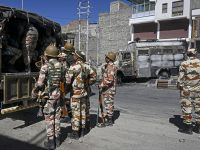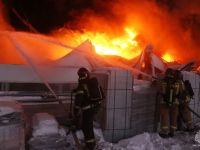Meanwhile, state oil company ONAREP (Office National de Recherches et d'Exploitation Petrolieres) on October 30, 2000 called for bids for exploration permits on eight blocks in the Atlantic Ocean offshore the Rabat-Safi area.
This is Morocco's first bidding round, with the final date for bids set for April 30, 2001, and awards expected by July 30, 2001.
Morocco produces small volumes of natural gas from the Gharb Basin in the north, and appears to have a considerable gas field at Meskala just north of Essaouira.
In January 2000, an energy ministry spokesman said that Morocco would soon issue new tax exemptions and other incentives to help attract foreign investors to explore for oil in Morocco.
In late December 1999, Morocco's Parliament unanimously adopted a new hydrocarbon law, which, among other things, offers a 10-year tax break to offshore oil production firms and reduce the government's stake in future oil concessions (to a maximum of 25 percent).
In October 1998, International Petroleum Investment Company (IPIC) of Abu Dhabi and Spanish Energy Company Cepsa formed a 50-50 joint venture called Cepsa Maghreb to market and distribute petroleum products and Liquefied Petroleum Gas (LPG) in Morocco.
Products are to be supplied from Cepsa's refineries in Spain, and French company Vitogaz is building an LPG import terminal and tank farm near Casablanca.
Meanwhile, Spanish oil and gas group Repsol has announced its intentions to invest $20 million in Morocco's energy sector over the next 5 years.
Repsol also reportedly is in negotiations with Lone Star on taking an interest in one of that company's license areas.
Morocco has two refineries (Mohammedia and Sidi Kacem) which have combined capacity of 156,630 bbl/d. Refining company Samir reportedly is planning to invest around $600 million over the next 5 years to modernize its refineries and to expand capacity.
Samir has a 125,230-bbl/d refinery at Mohammedia (near Casablanca), which it plans to expand to 160,000 bbl/d by 2002 (at a cost of $20 million).
On September 1, 2000, Morocco decided to increase the price of petroleum products in the country by 4.8 percent-10.8 percent, largely in response to increased world oil prices, as well as a weaker currency against the dollar.
Morocco contains only small natural gas reserves -- around 100 billion cubic feet (bcf), with about 85 percent located in the Essaouira Basin, and the rest in the Rharb and Pre-Rif basins.
This does not count any possible additional reserves at Talsint. Besides its own domestic gas reserves, Morocco is a major transit center for Algerian gas exports across the Strait of Gibraltar to Spain, via the 300-bcf/year, Maghreb-Europe Gas (MEG) pipeline (also known as the Pedro Duran Farell pipeline).
In November 1999, Spanish company Natural Gaz SDG announced its intention to invest up to $400 million in a natural gas distribution network for Morocco.
Coal and Electricity:
Morocco produces coal from its one mine at Jerada, and imports coal from the United States, Colombia, and South Africa.
Coal, most of which is imported from South Africa, is consumed largely by power plants at Mohammedia and Jorf Lasfar. With electricity demand increasing at around 7 percent annually, Morocco is expanding the $1.5-billion, coal-fired Jorf Lasfar plant (Africa's largest independent power plant) with the addition of two, 348-megawatt (MW), units by U.S.-based CMS Energy Corp.
When Unit 4 is completed (possibly by the end of January 2001), Jorf Lasfar will have total power generating capacity of 1,356 MW, and will supply more than half of Morocco's total power requirements. Units 1, 2, and 3 of Jorf Lasfar were completed in 1994, 1995, and June 2000, respectively.
Morocco's National Office of Electricity (ONE) has an ambitious plan to supply the countryside with electricity by 2010 (currently, only around 15 percent of the rural population has access to electricity).
Morocco plans to spend around $3.7 billion on energy projects through 2003, and part of this money will go towards building power plants and towards rural electrification.
As part of this plan, a new, $500-million, 350-400-MW combined-cycle power plant, to be fired by natural gas from the MEG pipeline, is planned.
The plant, Morocco's third independent power project (IPP), is to be built at Tahaddart, near Tangier in northern Morocco, with the first stage operational by 2002 and the second stage completed by 2004.
As of early 2000, three energy consortia reportedly were competing for the project: Germany's Siemens; General Electric; and a group led by ABB Alsthom.
In October 2000, the United States and Morocco signed an agreement on cooperation in energy efficiency and renewable energy.
In September 2000, Spain and Morocco, which put in place a 350-MW interconnection in 1998, agreed to study the potential for further linkage of the two countries' electricity grids.
ONE also is looking at solar power, as well as at building wind power parks throughout the country (including farms at Tangier and Tarfaya).
In late 1998, ONE awarded a $56-million construction contract to a French joint venture (CED) for a 50-MW wind farm to be built at Koudia el Beida near the Straight of Gibraltar.
In April 2000, Morocco said that it would build a 10-MW wind power plant in the northern city of Tetouan. If completed, this would be the first wind farm in Africa and the Arab world, according to ONE.
In September 1998, Endesa signed a deal with ONE to supply Morocco with 300 gigawatt hours of electricity through November 1998.
Meanwhile, a potential project to build a 50-MW solar power plant at Ouarzazate has been postponed. Morocco also has expressed interest in nuclear power for desalination and other purposes, but currently has no nuclear plants and no plans to build any.
Energy overview:Minister of Energy and Mines: Youssef Tahiri
Proven Oil Reserves (1/1/01E): 1.8 million barrels
Oil Production (2000E): 1,200 barrels per day (bbl/d), of which 200 bbl/d is crude oil
Oil Consumption (2000E): 149,000 bbl/d
Net Oil Imports (2000E): 147,800 bbl/d
Crude Refining Capacity (1/1/01E): 156,630 bbl/d
Natural Gas Reserves (1/1/01E): 47 billion cubic feet (Bcf)
Natural Gas Production/Consumption (1997E): 1.4 Bcf
Recoverable Coal Reserves (12/31/96): 6 million short tons (Mmst)
Coal Production (1999E): 0.32 Mmst
Coal Consumption (1999E): 3.85 Mmst
Net Coal Imports (1999E): 3.53 Mmst
Electric Generation Capacity (1/1/99E): 4.1 gigawatts (70 percent thermal, 30 percent hydroelectric)
Electricity Generation (1999E): 13.7 billion kilowatthours (bkwh)
Environmental overview:
Minister in Charge of Country Planning, Environment, Town Planning and Housing: Mr. Mohamed El-Yazghi
Total Energy Consumption (1999E): 0.41 quadrillion Btu* (0.1 percent of world total energy consumption)
Energy-Related Carbon Emissions (1999E): 7.6 million metric tons of carbon (0.1 percent of world carbon emissions)
Per Capita Energy Consumption (1999E): 14.5 million Btu (vs U.S. value of 355.9 million Btu)
Per Capita Carbon Emissions (1999E): 0.27 metric tons of carbon (vs U.S. value of 5.6 metric tons of carbon)
Energy Intensity (1999E): 13,057 Btu/ $1990 (vs U.S. value of 12,639 Btu/ $1990)**
Carbon Intensity (1999E): 0.24 metric tons of carbon/thousand $1990 (vs U.S. value of 0.20 metric tons/thousand $1990)**
Sectoral Share of Energy Consumption (1997E): Transportation (34.4 percent), Industrial (36.2 percent), Residential (24.4 percent), Commercial (5.0 percent)
Sectoral Share of Carbon Emissions (1997E): Transportation (36.6 percent), Industrial (36.6 percent), Residential (21.7 percent), Commercial (5.1 percent)
Fuel Share of Energy Consumption (1999E): Oil (73.2 percent), Coal (22.0 percent), Natural Gas (0.5 percent)
Fuel Share of Carbon Emissions (1999E): Oil (68.3 percent), Coal (31.3 percent), Natural Gas (0.4 percent
Renewable Energy Consumption (1997E): 38.6 trillion Btu* (5 percent increase from 1996)
Number of People per Motor Vehicle (1997): 20.8 (vs U.S. value of 1.3)
Status in Climate Change Negotiations: Non-Annex I country under the United Nations Framework Convention on Climate Change (ratified December 28th, 1995). Not a signatory to the Kyoto Protocol
Major Environmental Issues: Land degradation/desertification (soil erosion resulting from farming of marginal areas, overgrazing, destruction of vegetation); water supplies contaminated by raw sewage; siltation of reservoirs; oil pollution of coastal waters
Major International Environmental Agreements: A party to Conventions on Biodiversity, Climate Change, Desertification, Endangered Species, Hazardous Wastes, Marine Dumping, Nuclear Test Ban, Ozone Layer Protection, Ship Pollution and Wetlands. Has signed, but not ratified, Environmental Modification and Law of the Sea
* The total energy consumption statistic includes petroleum, dry natural gas, coal, net hydro, nuclear, geothermal, solar and wind electric power. The renewable energy consumption statistic is based on International Energy Agency (IEA) data and includes hydropower, solar, wind, tide, geothermal, solid biomass and animal products, biomass gas and liquids, industrial and municipal wastes. Sectoral shares of energy consumption and carbon emissions are also based on IEA data.
**GDP based on EIA International Energy Annual 1998
Oil and gas industries:
Organization: Office Nationale de Recherches et d'Exploitation Petrolieres (ONAREP) is the national (upstream) oil company.
Major Oil Fields: None
Refineries (capacity-bbl/d): Samir -- Mohammedia (125,230); Ste. Cherifienne des Petroles -- Sidi Kacem (31,400)
Ports: Jorf Lasfar, Casablanca
Pipelines: The Maghreb-Europe Gas (MEG) pipeline passes through Morocco from Algeria en route to Spain.
Major Foreign Energy Company Involvement: Cepsa, CMS Energy, Conoco, Energy Africa, Enterprise, Kerr-McGee, Lasmo, Lone Star/Skidmore, Mobil, Repsol, Shell, Total, Vanco.
Source: United States Energy Information Administration.
© 2001 Mena Report (www.menareport.com)







